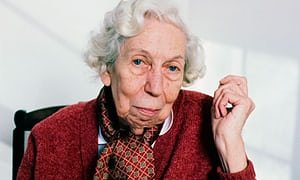Female Gender Roles in Literature (2/3)
Female Gender Roles in the Works of Katherine Anne Porter, Eudora Welty, and Richard Wright

Eudora Welty Source
In this essay I will discuss,
The treatment of female gender roles in the works of three authors: Katherine Anne Porter, Eudora Welty, and Richard Wright. In reading Porter’s “The Old Order” and the character, Sophia Jane, Welty’s “Moon Lake” and the girls at camp, and Wright’s Black Boy and this novel’s female characters.
I became interested in these author’s treatment of their female characters; how their female characters deal with issues of gender, and what happens when gender lines are crossed. While most female characters in these works are written as passive and submissive, once in a while I’d come across one who was active and assertive, traits that are specifically masculine. Sadly these females are desexualized being written as motherly, elderly and unattractive. Portraying women in this fashion seems to minimize the threat to men and their patriarchal hierarchy.
The portrayal of women and men’s reactions are the main topics of this essay.

Source
The last section covered women.
What about young ladies and little girls? How are younger females characters gendered? In Eudora Welty’s “Moon Lake,” her
“…use of phallic imagery keeps readers continually aware of the tensions between the young girls’ desires and the society which tries to shape [them]”
(Yaeger 431)
This story takes place during a camping trip to the lake with a group of young girls, some orphans, and Loch Morrison, Boy Scout and lifeguard. During the course of the week one of the girls, Easter, drowns. She jumped from a diving board into the lake, but never surfaced. Loch, desperate to save Easter’s life takes no care with her body, violating her in ways that mirror rape.
“Astride Easter the Boy Scout lifted her up between his legs and dropped her. He did it again, and she fell on one arm…The Boy Scout reached in and gouged out her mouth with his hand, an unbelievable act”
(Welty 365-66)
Jumping into the lake from a diving board is seen as a masculine activity- a penetration of the water. Easter, participating in said masculine activity has crossed over traditional gender roles; something acceptable in females only until puberty sets in.
Easter on the threshold between childhood and adulthood, the eve of puberty, essentially goes into the water, drowns, and returns.
“It is as if [Easter] has traveled too far into masculine territory and must learn “feminine” passivity through the violence of a ritual rape”
(Yaeger 438)
This ritual rape defines Easter’s rite of passage from an active non-gendered life, to a passive gendered life. A life in which Easter plays the traditional female gender role as defined by masculine hierarchy.
Adding to the ritualistic interpretation of Easter’s rescue is that her body had been laid out upon a table and positioned in much the same way that Christ’s body was hung upon the cross. Thus,
“[s]exually crucified, Easter becomes a symbol for woman’s otherness as sexual object”
(Yaeger 441)
There is a danger in this female symbology however as Easter has a choice; because she has a choice she is feared.
“She is feared because her real and human power- which will come to maturity as she comes of age- carries with it a capacity for rebellion against that law which has been unable before puberty to define her”
(Yaeger 440)
A woman’s capacity for rebellion coupled with the effect of her choices on future generations is what masculine, patriarchal hierarchies fear most.
Thus female symbology is suppressed and attention is once again focused on men, masculinity, and patriarchy. Symbology thus shifts to man’s penis.
“The penis…is a physical organ which is not the effective cause of [man’s] power, but is, rather, an object fetishized by culture as a symbol of man’s power over nature, over himself, and over woman”
(Yaeger 448)
According to Yaeger‘s interpretation of Welty, this sort of female disempowerment is ultimately seen as a “sham” (Yaeger 449).
“The power of sexual patriarchy, Welty tells us, is all too real, but its punitive source, its central and symbolic instrument of feminine disempowerment, is a cultural delusion, a sham. The phallic must be seen…as a dangling signifier, a ‘minnowy thing,’ a peevish light which is attached loosely and vulnerably to the male body and cannot be described in terms of itself, but only through the unstable mediations of metaphor”
(Yaeger 449)
 Source
SourceWorks Cited
Frankwitz, Andrea. “Katherine Anne Porter’s Miranda Stories: A Commentary on the Cultural Ideologies of Gender Identity.” Mississippi Quarterly 57:3 (Summer, 2004): 473-488.
Keady, Sylvia H. “Richard Wright’s Female Characters and Inequality.” Black American _Literature Forum 10:4 (Winter 1976): 124-128.
Porter, Katherine Anne. The Old Order. Orlando: Harvest, 1972.
Welty, Eudora. The Collected Stories of Eudora Welty. Orlando: Harvest, 1980.
Wright, Richard. Black Boy. New York: Harper Perennial, 2006.
Yeager, Patricia S. “The Case of the Dangling Signifier: Phallic Imagery in Eudora Welty’s ‘Moon Lake’” Twentieth Century Literature 28:4 (Winter, 1982): 431-452.
)
)
)
)